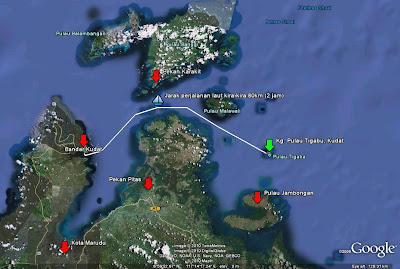Can communities manage their own resources?
Saturday, 8th August 2009. In the past two days, we hosted a visit from the newly created Environment and Conservation Unit of the Sabah Fisheries Department. We felt very privileged to host the visit of the full team of the unit that also happen to handle the SSME Tri-National Programme in Sabah, of which our project is closely affiliated. On the first day, bad weather threatened to completely ruin our plan to bring our guests to the many places within the proposed Tun Mustapha Park (TMP) that we thought would be a ‘must visit site’. But ‘good’ weather prevailed - the rain stopped and the wind subsided enough to allow us to visit at least two of the 4 sites we planned to visit. The visit to Kg. Berungus, Pitas and Karakit, Banggi was worth the rough boat ride across Banggi Channel and the perilous short cross over a fishing vessel and fish cages to get to dry land in lieu of a proper jetty. The discussions the next day was equally rewarding and enlightening for us in the WWF team.
 Dr. Norasma and team from the Sabah Fisheries Department visiting Kg. Berungus, Pitas, with WWF-Malaysia Team
Dr. Norasma and team from the Sabah Fisheries Department visiting Kg. Berungus, Pitas, with WWF-Malaysia TeamBut then TMP would be a different Park compared to its predecessors. TMP will probably fall under the IUCN Category VI park meant for sustainable resource management. It will involve zoning of areas for many different uses - including fisheries management and protection of biodiversity, and resource users are able to participate in resource management through the practice of collaborative management. Hence the question “Can communities manage their own resources?”.

We finally selected 4 candidates from TMP representing our self-created sub-regions of Kudat, Kota Marudu, Pitas and Banggi - Mr. Johny Wong, Pakcik Musana, Mr. Sabran Mohammed and Mr. Zaman Bayang representing Kudat, Banggi, Pitas and Kota Marudu sub-regions respectively.
Fast forward to today, August 2009, 3 years onwards.
Mr. Johny Wong has established a group called Persatuan Pemilik Kapal Nelayan Kudat (PPKNK) and is now the secretary of this group. Members of PPKNK had participated in the stakeholder consultations for TMP to identify important fishing ground, issues and recommendations for better management of commercial fishing in TMP. PPKNK advocate control of fishing effort in TMP to address overfishing, keen to learn new technologies that can help them practice sustainable fisheries and reduce by-catch and is willing to participate in discussions and management of TMP.


Pakcik Musana was instrumental in the initiation of work towards the establishment of Maliangin Sanctuary as a pilot site to demonstrate the benefits of marine protected area - socio-economic through establishment of alternative livelihoods, increase fish catch through spill-over effect of no-take zone, improved biodiversity and the implementation of the concept of collaborative management. Warmly welcoming us into his community, we were able to work with his Community to establish Maliangin Sanctuary. Boundary for Maliangin Sanctuary is now being identified and a Maliangin Committee is being formalized with the Registrar of Society (RoS) to help in the formation of Maliangin Sanctuary. Simultaneously, alternative livelihood is also being identified and piloted for implementation.
 Aerial view of Maliangin Sanctuary
Aerial view of Maliangin Sanctuary Beautiful beach on Maliangin Besar
Beautiful beach on Maliangin Besar Potential alternative livelihood on Maliangin Sanctuary
Potential alternative livelihood on Maliangin Sanctuary Maliangin committee in the making - En. Abd. Aziz chairing the Maliangin Community Meeting.
Maliangin committee in the making - En. Abd. Aziz chairing the Maliangin Community Meeting. Honorary Wildlife Wardens being trained in the use of Global Positioning System (GPS)
Honorary Wildlife Wardens being trained in the use of Global Positioning System (GPS)
As we continue engaging the communities of TMP, communities proactive in resource management emerged. Kg. Berungusis one of them. We visited Kg. Berungus in Pitas in February 2007 as one of the site surveyed during our community survey. There we found out that when it come to participation in resource management, Kg. Berungus is far ahead. The Pengerusi JKKK, Encik Abdul Karim is strong in his commitment to prevent cyanide fishing and fish bombing from happening in his village. He is assited by Encik Jamili who is equally committed, and youth of Kg. Berungus, strong supporters of their elders. This commitment came from their awareness that these destructive fishing practices is destroying the very resources that their livelihood is dependent on. Being former practitioners, they knew and understand the impact of the practice and are very effective in protecting their resources.
 Beautiful beach of Kg. Berungus, Pitas
Beautiful beach of Kg. Berungus, Pitas View of the sea from Kg. Berungus
View of the sea from Kg. Berungus Encik Abdul Karim conductinng monitoring with his son, Kamaruddin.
Encik Abdul Karim conductinng monitoring with his son, Kamaruddin. Kamaruddin from Kg. Berungus receiving a digital camera, binocular and GPS from Dr. Rahimatsah, Chief Technical Officer of WWF-Malaysia. Dr. Rahim is also an Honorary Wildlife Warden.
Kamaruddin from Kg. Berungus receiving a digital camera, binocular and GPS from Dr. Rahimatsah, Chief Technical Officer of WWF-Malaysia. Dr. Rahim is also an Honorary Wildlife Warden. Picture of the cyanide fisher and the squirter containing cyanide poison used in cyanide fishing.
Picture of the cyanide fisher and the squirter containing cyanide poison used in cyanide fishing. Author joined En. Abdul Karim and son, Kamaruddin monitoring fishers activities around their village.
Author joined En. Abdul Karim and son, Kamaruddin monitoring fishers activities around their village. 



Comments
Post a Comment